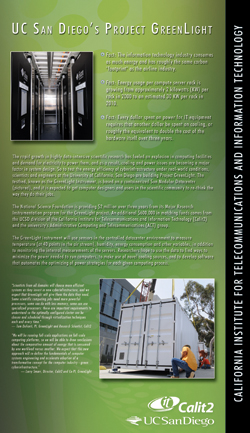UC San Diego Goes 'Green' at SC08
SDSC Partners with Calit2, EVL, UC San Diego Sustainability Program and CENIC to Highlight Green Technologies and Applications
San Diego, Nov. 13, 2008 -- The San Diego Supercomputer Center and two other UC San Diego entities are combining forces to showcase "green" technologies this month at SC08, the leading international conference on high-performance computing, networking, storage and analysis. The UC San Diego division of the California Institute for Telecommunications and Information Technology (Calit2) and the university's Sustainability Program are partnering with SDSC to showcase new initiatives and cyberinfrastructure technologies that save energy, reduce travel, and protect the planet's environment.
|
Also joining the partnership for 2008 is the Electronic Visualization Laboratory (EVL), based at the University of Illinois at Chicago, and the Corporation for Education Network Initiatives in California (CENIC).
The collaborative booth will feature demonstrations and talks about “green” data centers as well as cyberinfrastructure and the scientific discoveries it enables. The annual conference on supercomputing is being held November 17 through 20 at the Austin Convention Center in Austin , Texas . Visitors to the SDSC/Calit2/EVL/CENIC booth (#568) can attend presentations and receive information on the many projects and partnerships currently going on at SDSC and its partner sites.
“UC San Diego is a national leader in ‘green’ techniques and technologies, and is spearheading innovations to lower energy consumption from data centers and other buildings, thereby reducing carbon-based pollutants,” said Fran Berman, SDSC director. “We at SDSC and our collaborators from Calit2, and the campus’ Sustainability Program, along with EVL and CENIC , show what can be done to monitor and improve energy efficiency, clean up our environment, and develop ‘green’ cyberinfrastructure.”
Specific topics, for example, include efforts to monitor and reduce “carbon footprints” from data centers; studies about biomass in the tropics and water in our nation; new optical networks and end-points for virtual scientific meetings that reduce the need for business travel and hence lower energy consumption; grid-enabled neurosurgical imaging; and UC San Diego sustainability initiatives such as the use of solar energy for campus buildings and biofuels for campus vehicles.
Calit2, SDSC and CENIC will brief conference-goers on the National Science Foundation-funded Project GreenLight, which is building instrumented modular server facilities to do real-world testing of computing and other IT services to gauge their environmental impact. “GreenLight researchers will test and compare various hardware, system software, and virtualization designs and configurations to determine which optimizations provide the greatest work per watt,” said GreenLight Principal Investigator Tom DeFanti, Calit2’s director of visualization.
In addition, the display booth has been configured to showcase several high-performance visualization efforts. Demonstrations include the use of Calit2’s OptIPortable, a mobile, networked and scalable, high-resolution LCD tiled display wall, driven by a Rocks-managed Linux cluster, that enhances the ability of scientists to access remote high-performance computing resources from their local labs. Mike Norman, SDSC’s chief scientific officer, is exploring the potential of the OptIPortable as well as fixed-location OptIPortals to serve as visualization and analysis end-stations for multi-terabyte data sets arising from petascale simulations that run on TeraGrid resources.
UC San Diego is one of the nation’s greenest universities -- a local, national and global leader in climate change solutions. Modern climate change science began with the Keeling Curve, the first measurement of the greenhouse gas build-up by researchers at Scripps Institution of Oceanography at UC San Diego. Scripps remains one the world’s leading climate change research centers. UC San Diego also has one of the largest green energy programs on a university campus, and it is a leader in advancing energy efficiency in information technology. Across the campus, researchers, faculty, staff and students collaborate to create a campuswide commitment to climate solutions, from composting at dining halls and creating biofuels from algae to developing alternative transportation for university commuters and building green housing for students. UC San Diego offers more than 200 courses and has 83 student organizations focused on environmental sustainability.
EVL, in collaboration with Sharp Laboratories of America, will use Sharp’s prototype 4K LCD display (four times the resolution of HDTV) to create a sustained global teleconference by networking to two other booths on the SC08 show floor in Austin, two Midwestern universities, and several research institutes in Australia, Russia and the Czech Republic. In addition, EVL will debut TacTile, its new multi-touch, 52-inch LCD tabletop display that puts interaction with high-definition scientific imagery at one’s fingertips—literally.
For more information about many other SDSC activities at SC08, download the complete agenda. To learn more about SC08, visit the conference website.
Related Links
San Diego Supercomputer Center
SC08 Conference Website
University of California, San Diego
California Institute of Telecommunications and Information Technology
Electronic Visualization Laboratory
UC San Diego Sustainability Program
Project Greenlight
CENIC
Media Contacts
Doug Ramsey, 858-822-5825, dramsey@ucsd.edu

